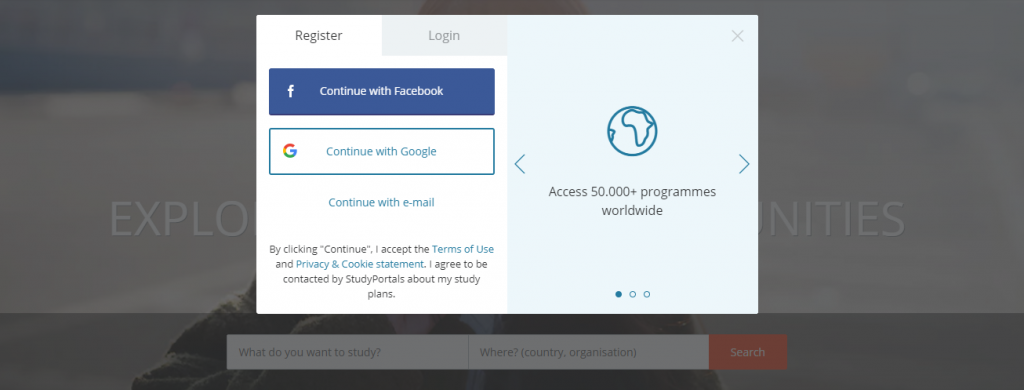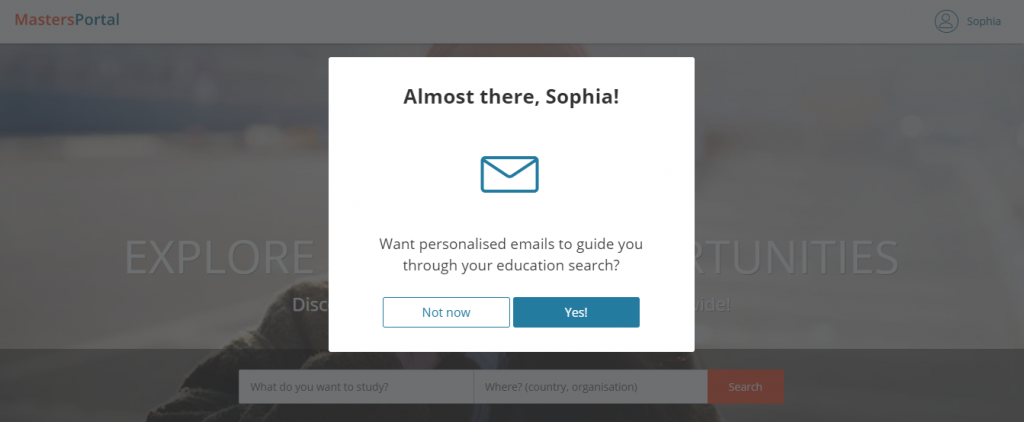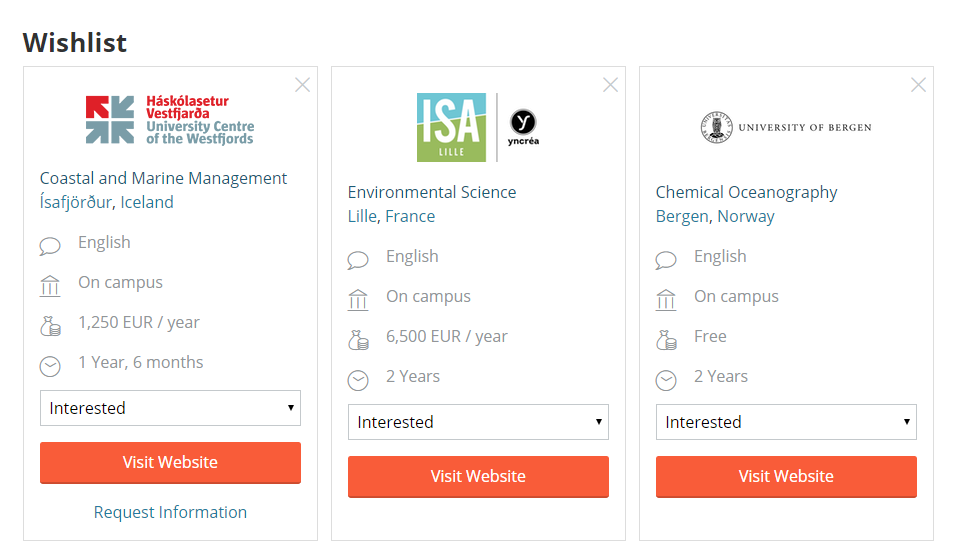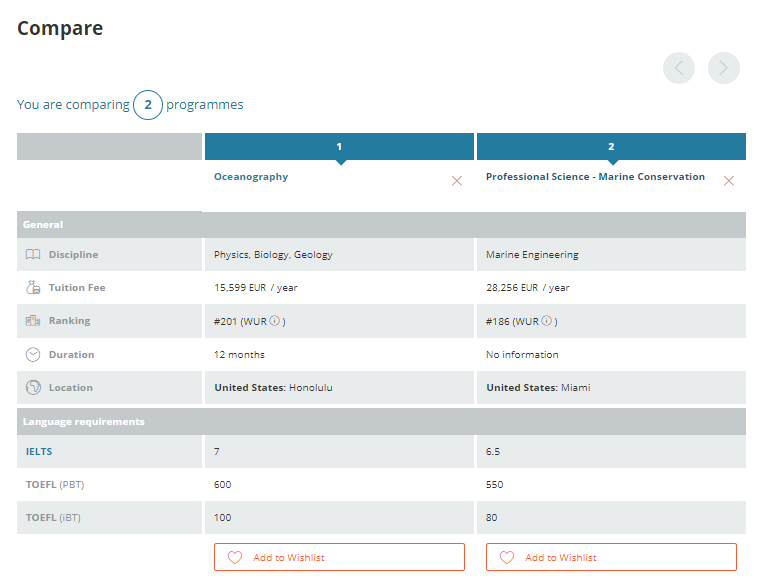Relevant results, better choice: or why we encourage website registrations | part 5
Product Innovation Part 5: Encouraging website registrations
This is the fifth article in a series of articles, documenting the processes and steps we take towards improving and innovating our platforms. By understanding the student journey in and out, we’ll show how a platform can be built that is valuable to students and agile to the demands of international education.
Have you noticed that every time you shop online, you’ll end up seeing more and more of the items you were browsing through subtly return to the side-bar of your screen? You were logged into Amazon, looking for a record player; and then you’re scrolling through Facebook or checking your e-mail, and you’re seeing ads for similar, if not the same, record players.
At first, you might consider it annoying, but think again: how likely are you to buy the first record player you happen to come across online? Wouldn’t you want to see all there is and compare quality, prices, and design?
Instead of spending hours searching across different sites or a countless number of pages for the ideal record player, some companies would do the work for you and suggest similar, “you-might-also-like” or complementary kind of items to make your search easier, your choices faster, and your experience more complete, right away. For example, accommodation sites will suggest hotels at similar prices at nearby locations, flight providers would suggest car rentals and hotels for the destination you’re flying to, fashion stores will suggest “complete the look” pieces, all based on your purchase preference. Handy, isn’t it?
In the same fashion, Studyportals strives to help students find the degree programmes they’re most interested in, allowing them to first see all similar programmes available, compare them, and finally choose their ideal match. As students navigate through the options, we also help them narrow down their shortlist to the programmes with the most realistic chance of admission. To do all this, we take a deeper look at what each student is looking for.
Starting with a profile
Recently, we’ve introduced a log-in pop-up that will prompt students to register with Studyportals during their first session on one of our portals. Basically, once a student has looked at three different pages, one of them being a programme page, we think it’s a good time to ask them to register. In this way students can create a profile: a space of their own, where they can save their personal information, organize programmes, keep track of the ones they compared, and compose a wishlist of programmes they’re interested in, like a Pinterest board. No more ‘’Where was that university?’ ‘What was the programme called?’’, ‘The tuition fee?’ ‘Did I need visa for this one?’ Below, we’ll touch on some more of the benefits that this registration tool has not only for students, but also for universities.
Navigating students through their choice: from visit to enrolment
Often, when students begin a session on Studyportals, they begin with a general idea in mind. They start with the discipline they’re interested in, or the country they want to go to, and then decide from there based on the relevant search results where they want to go.
Before they go too far, and get lost down a rabbit hole of information, we can help them stay organised, and make sure they know how to make the best use of our portals. To do that, we need to know what is relevant to them. So, after they’ve looked at three pages, we bring students to a registration wall, telling them to register first if they want to see any other pages. The sooner they provide us information about themselves, the sooner we can provide them features that they can use to narrow down their education search.
Once students fill in a profile, they can start designing what would become their study choice master plan. For students, this is in fact quite helpful in three ways: they get to pin programs to their a wishlist, receive updates with smart suggestions of related programmes and events, and find customised admission information based on their background, credentials, and interests.
If a user wants to keep searching through multiple degree options, she can save the programmes she’s viewing to a wishlist, and come back to it later on, or even another day. This makes sure that, as more and more programmes and information are available, we keep them up-to-speed on relevant information.
Additionally, students can save several programmes to a comparison tool, and see how they match up in terms of duration, tuition costs, location, starting date, and requirements. Then, after a while, students will receive relevant updates and newsletters based on what they tell us in their profiles.
Following the student journey
For universities, it’s often difficult to differentiate between users that may have the potential to apply and enrol, and those who are just browsing for information, or who may have found their programme by accident.
Studyportals tries to send only the right students to your institution: the ones who are actively searching, match your institution’s requirements, and are likely to apply within one to six months. Having an early registration pop-up allows us as well as an education institution better track the users who view the programmes on our portals.
We always keep in mind that the decision-making process of a student takes on average 6 months. This is why the sooner they’re registered, the sooner we’re able to help point them in the direction of your programmes, and make sure that they are matched with the right universities. If a student, for example, who has filled out all the information – including nationality, education background, and discipline(s) of interest – then decides to look at your programme’s listing, you have a better idea of whether she is someone who is likely to apply to your university, and can have a better idea of what kind of information prospective students find relevant.
Moreover, when it comes to marketing research, you have a clear picture not only of students’ backgrounds and interests; you also have a wide range of data about which regions they are coming from, what their credentials are, and what their user journeys tend to entail – from beginning to end. Like tailoring a list of student personals for your university.
Finally, with our targeted mailing newsletters, we showcase the programmes that your universities offer to students who have expressed a genuine interest in them, right at the moment that they’ve begun their search.
Relevant information yields more qualified applicants
When students register to create a profile, they make the symbolic first step to their discovery-to-shortlist phase.
It’s an indicator that students find our portals useful and are ready for more information. It also means they’re eager to use our portals for a longer time. We conclude, therefore, that the content that is displayed for them is something that they’d like to see more of, and that we’ve made it more inviting, readable, and relevant.
So, for Studyportals, we can also make sure that we are keeping our product and platform relevant and useful to students. By assessing the ‘conversion-rate’ (i.e. the rate by which users become registered members), we also are able to get a strong picture of how users view our portals, and whether they’re interested in getting information from us. As a result, we’re ensuring that we’re displaying information about your universities that they can trust, and that they are eager for more information that we can share with them.
Read more about Product Innovation at Studyportals
Part IV – mobile-friendly display
Part III – improving search results
Part II – insights into visa requirements
Part I – adding transparency about admission chances
About the series – introduction
For more updates, follow us!










